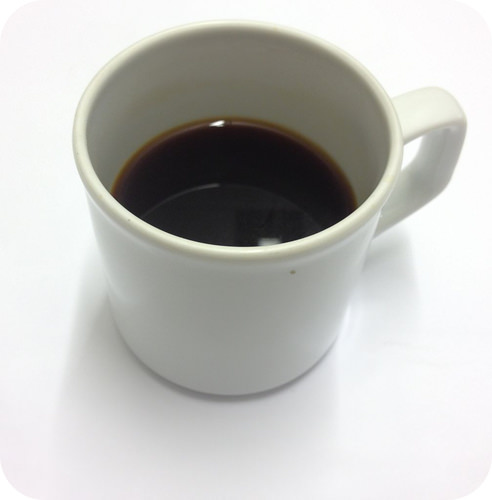15.5 解散进程
章节大纲
-
How do you take your coffee?
::咖啡怎么喝? 咖啡怎么样?Many people like to start their day with a cup of coffee (others need coffee all day long in order to get anything done). The coffee you drink is a type of solution, often a very complex one. The coffee itself has been brewed so that material from the coffee bean will dissolve in hot water. Some people add sugar, while others add milk or cream. In some areas of the country, lattes are popular; so one or more special flavors might be added along with the milk. Whatever the situation, the end-result is an enjoyable solution to drink.
::许多人喜欢用一杯咖啡来开始自己的一天(其他人需要一整天的咖啡来做任何事情)。你喝的咖啡是一种解决办法,往往是一种非常复杂的解决办法。咖啡本身已经酿好,咖啡豆中的材料会溶解在热水中。有些人加糖,而其他人加奶或奶油。在国内一些地区,拿铁很受欢迎,因此可以加上一种或多种特殊口味和牛奶。不管情况如何,最终的结果是饮用一种令人愉快的解决办法。The Dissolving Process
::解散进程Water typically dissolves many and . Nonpolar molecules such as those found in grease or oil do not dissolve in water. We will first examine the process that occurs when an ionic compound such as table salt (sodium chloride) dissolves in water.
::水通常会溶解很多,并且会溶解很多。在油脂或油液中发现的非极分子不会溶解在水中。我们将首先检查在水中溶解的如食盐(氯化钠)等离子化合物时发生的过程。Water molecules move about continuously due to their . When a crystal of sodium chloride is placed into water, the water’s molecules collide with the crystal lattice. Recall that the crystal lattice is composed of alternating positive and negative . Water is attracted to the sodium chloride crystal because water is polar and has both a positive and a negative end. The positively charged sodium ions in the crystal attract the oxygen end of the water molecules because they are partially negative. The negatively charged chloride ions in the crystal attract the hydrogen end of the water molecules because they are partially positive. The action of the polar water molecules takes the crystal lattice apart (see image below).
::水分子由于水分子不断移动。当氯化钠晶体被注入水中时,水分子会与晶体板相撞。回顾晶体板由交替的正和负组成。水被氯化钠晶体吸引,因为水是极的,有正和负的两端。水晶中正充电的钠离子会吸引水分子的氧端,因为它们是部分负的。晶体中负电氯化离子会吸引水分子的氢端,因为它们是部分正的。极水分子的动作将晶体板分开(见下文图示)。After coming apart from the crystal, the individual ions are then surrounded by solvent particles in a process called solvation . Note that the individual Na + ions are surrounded by water molecules with the oxygen oriented near the positive ion. Likewise, the chloride ions are surrounded by water molecules with the opposite orientation. Hydration is the process of solute particles being surrounded by water molecules arranged in a specific manner. Hydration helps to stabilize aqueous solutions by preventing the positive and negative ions from coming back together and forming a precipitate .
::与晶体分离后, 个别离子会被溶剂粒子所包围, 过程称为溶解。 请注意, 个别纳+离子会被水分子所包围, 氧向正离子附近。 同样, 氯化离子会被水分子所包围, 方向相反。 水力化是溶液粒子被水分子以特定方式安排的。 水力化有助于稳定水溶液, 防止正和负离子复合并形成加速器。Table sugar is sucrose (C 12 H 22 O 11 ) and is an example of a molecular . Solid sugar consists of individual sugar molecules held together by intermolecular attractive forces. When water dissolves sugar, it separates the individual sugar molecules by disrupting the attractive forces, but does not break the between the carbon, hydrogen, and oxygen atoms. Dissolved sugar molecules are also hydrated, but without as distinct an orientation to the water molecules as in the case of the ions. The sugar molecule contains many -OH groups that can form with the water molecules, helping form the sucrose solution.
::纯糖由个别的糖分子组成,由中间分子有吸引力的力量组成。当水溶解糖时,它通过破坏有吸引力的力量而分离个别的糖分子,但不会打破碳、氢和氧原子之间的分解。溶解的糖分子也水化,但没有像离子那样对水分子有不同的定向。糖分子含有许多 - OH 组,可以与水分子形成,帮助形成苏格溶液。Summary
::摘要-
Motion of water molecules helps break up interactions between solid ions or molecules.
::水分子运动有助于分解固体离子或分子之间的相互作用。 -
Solvation involves surrounding ions with solvent particles.
::溶解涉及带溶剂粒子的周围离子。 -
Ionic solute molecules are hydrated (surrounded by solvent molecules in a specific orientation).
::溶液分子是水合的(由特定方向的溶剂分子环绕)。
Review
::回顾-
How does the motion of water molecules help form a solution?
::水分子运动如何帮助解决问题? -
What is solvation?
::什么是孤独? -
What is hydration?
::什么是水分? -
How does sucrose interact with solvent water molecules?
::苏格罗斯是如何与溶剂水分子相互作用的?
-
Motion of water molecules helps break up interactions between solid ions or molecules.

